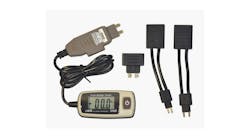From 2004 to 2006, the Mazda RX8 used a 4-speed, fully electronic transmission from JATCO called the JR405E. Mazda calls it the RC4A-EL transmission. Approximately 48,000 of these cars using this transmission were sold in the U.S. Around the world, it has had a bit longer of a life. In fact it was used in the Chevrolet Colorado from 2004 to 2011. Here in the U.S., the 4L60E transmission was used. I don’t know how many of these 48,000 are still on the road today, but every once in a while we get a call on this transmission. And the rare times this transmission shows up on your door step, it’s good to have some information so you can diagnose and repair the vehicle.
A good place to start is with a simple component application chart as seen in Figure 1. The location of the clutch assemblies inside the transmission are provided in Figure 2. The application chart also provides solenoid and pressure switch activity which we will go over further in this article. But for now, a quick look at the application chart in Figure 1 shows how the Low clutch is on for 1st, 2nd, and 3rd gear and releases in 4th. When a shift into 2nd takes place, the 2-4 brake is applied. This makes the 1-2 shift transition non-synchronous in that no timing is involved in releasing one clutch and applying another.
FIGURES 1-4But the 2-3 and 3-4 shifts are another story; they are synchronous. The 2-4 brake releases while the High clutch is applied for a shift into 3rd. The Low clutch releases while the 2-4 brake applies for a 3-4 shift. This is essential to observe, as there are significant additions to diagnosing harsh synchronous shifts as opposed to a non-synchronous shift.
Characteristically, with a non-synchronous shift, you would need to consider pressure control, accumulator control, cushion plates, clutch clearances or band travel, orifice controlling check balls and fluid to friction compatibility. The same could be said for synchronous shifts with the addition of computer calculated adaptations for clutch release and apply timing control and temperature. Depending on the type transmission involved, this also might include counter balance pistons.
The RC4A-EL utilizes this strategy with the Low (Figure 3) and High (Figure 4) clutch assembly. They refer to this as a centrifugal balance system. It replaces the conventional piston check ball. Centrifugal head oil pressure generated during clutch drum rotation is used to prevent clutch drag-engagement and to stabilize piston pressure during full rotation.
To take this a little deeper, you would need to determine what solenoids and regulating valves are involved in the specific shift transition giving troubles. This also includes bushings and sealing rings that are in play. When it comes to the RC4A-EL, there are pressure switches involved, particularly the 2-4 clutch pressure switch and the High clutch pressure switch (Figure 5). Without exhausting all the variables, there still remains quite a laundry list of items to consider when fighting harsh or slipping shifts; especially synchronous shifts.
Before we take a closer look at some of the solenoid controls in this transmission, I would like to mention a little about adaptation control. With different manufacturers come different computer strategies with which to determine clutch adaption. You can, however, usually count on a number of inputs to be common ground among them all. The first being engine load. This is a big input. It’s good to remember that as time goes by, engine input data can become skewed for a wide variety of reasons. This ultimately will affect shift feel. Engine and/or transmission fluid temperature, speed sensors and a healthy electrical system are other critical inputs that influence clutch adaptation.
With that said, the first area in the hydraulic operation of this transmission to look at is the pressure control solenoid (Figure 6). This is a normally applied solenoid that measures between 12.3 to 16.3 ohms. It is fed with pilot valve pressure (solenoid regulating pressure), which the solenoid uses to raise and lower line pressures. The interesting aspect about this solenoid is that it is an On/Off type solenoid. When it is off, it directs pilot pressure to the spring side of the pressure regulator valve placing it at maximum pressure. When it is on, it blocks pilot pressure to the pressure regulator valve placing it at the minimum pressure position. The range is 46-65 psi low to 164-193 high in the Drive range. It is the Normally Applied clutch pressure control solenoids (Figure 7) that duty cycles at 50 Hz (20 ms cycle) to indirectly control clutch apply and release pressure. They have a specification range of 2.7 to 4.4 ohms.
FIGURES 5-8Shift solenoid A controls the Low clutch pressure via an amplifier valve. This was the first time I saw a valve called by this name. I suppose the Low clutch could be called the low clutch Speaker. Well, thank goodness I do not get paid for my jokes. Continuing on, shift solenoid B controls the 2-4 Brake while shift solenoid C controls the High clutch through their respective amplifier valve. Shift solenoid F controls the Low and Reverse clutch via a L/R switch valve.
Another interesting shift control strategy unique to this transmission is the 2-4 clutch and high clutch each has both a pressure switch in their hydraulic circuits and accumulator pistons. Pressure switch signals and accumulator pistons for these two clutch assemblies assist in controlling smooth synchronous shifting. These pressure switches are rated to close between 57 and 71 psi.
To bench test these switches, simply place the positive meter lead on the single terminal located at the top of the switch. Place the negative lead to the base of the switch where the threads are located. The meter should read open. When 57 to 71 psi of air is supplied to the switch, continuity should be observed. The 2-4 pressure switch provides information to the computer for finer control of the 1- 2 and 3-4 shifts. The High Clutch Pressure Switch for the 2-3 and the Low/Reverse for a garage shift into Reverse. Each of these pressure switches receives a 12 volt signal. When the switch closes it pull the voltage down to below 1 volt.
In addition to that, each of the duty cycle solenoids has its own accumulator pistons as well. The idea here is to provide a smoother stroking of their respective valves, which provides smoother clutch apply and release pressure (see SSA and SSB as an example in Figure 7).
The parameter in the scan tool for these duty cycle solenoids will be presented in percentage. As mentioned previously, these duty cycle clutch solenoids (shift solenoids) are Normally Applied solenoids. A zero percent duty cycle will indicate full apply, while a 99 percent duty cycle will indicate full release. The Lock-Up duty solenoid works in the opposite manner. This is a Normally Vented solenoid which would mean that a zero percent duty cycle will indicate a fully released converter clutch, while 99 percent will indicate a fully applied solenoid. The Pressure Control Solenoid and Pressure switches will be displayed as On or Off.
The turbine shaft speed sensor (TSS) and output shaft speed sensors (OSS) are both Hall Effect type. These sensors are supplied with 12 volts and a ground. The sensor will then provide a zero to 5 volt pulse back to the computer. It is recommended that when checking this signal using a scope, to set it at 5V division and 250 microseconds.
FIGURES 9-12The scan tool will show this input in rpm. This is especially helpful should gear ratio needs to be calculated. This transmission has a 2.785 for 1st, 1.545 for 2nd, 1:1 for 3rd and 0.69 for 4th. A screen capture of the speed sensors can be used to verify a slipping or holding clutch. Dividing the OSS rpm into the TSS rpm will provide the recorded ratio. A TSS, for example, with an rpm of 1,785 divided by an OSS rpm of 642 will equal 2.780. A gear PID and a Gear ratio PID is also provided in the data monitor list as well. This is a great way to inspect the health of the converter clutch. When fully applied, TSS should equal engine speed.
There are a variety of PID’s available for the transmission range sensor (Figure 8). They are:
1. The Park/Neutral position switch (CPP/NP) displaying P/N, R, D or M range.
2. Transmission Range (TR) displaying R, N and D.
3. D range Switch (TRD) displaying D On/Off.
4. R position switch (TRR) displaying R On/Off. A PID for the Manual (M) range will also be displayed as On/Off.
5. M range switch (MNL SW) displaying M range On/Off
6. Up Switch (UP SW) displaying Up-shift On/Off.
The range sensor itself is easy enough to check electrically. Ignition power is supplied to the C(2) terminal. When in Park, this voltage is supplied to the A(1) terminal. In Reverse, it’s present on the E(3), in Neutral the D(7) and Drive the G(4) terminal. When aligning this sensor, align the square notch in the TRS lever with the square notch in the case (Figures 9 and 10). This is the Neutral position. Adjust the TRS sensor to read Neutral: continuity between C(2) and D(7) then tighten the switch to case (Figure 11).
Two PIDs are offered for the transmission fluid temperature sensor, one in degrees Fahrenheit or Celsius (TFT), the other in signal voltage (TFTV). The signal wire supplies the sensor with 5 volts. As the sensor resistance decrease when temperature increases, this 5-volt signal will drop. Factory specifications place the voltage to be 1.55 at 68° F. A temperature to sensor resistance chart is provided in Figure 12.
When this transmission was first released, the manufacturer claimed that the RC4A-EL type was newly developed as an automatic transmission with state-of-the-art technology. For improved shift quality, it used direct electronic shift control via the duty-cycle shift solenoids briefly covered in this article. It also cited the use of a feedback control system, a centrifugal balance clutch chamber system (Low and High Clutch also mentioned in this article) and a late-type clutch pack replacing the 2-4 brake band.
It is amazing how in just a few years this state-of-the-art technology has become near common place. And with the passing of time, some of these added features will begin to fail compromising the quality of the shift. Having now a little insight and information with this rare transmission, it will not be a stranger to you when it arrives in your shop.
Subscribe to Motor Age and receive articles like this every month…absolutely free. Click here













